Fresh back from another winter in Mexico, Paul Beddows cuts through the hysteria and tells us the latest we need to know about truck camping in Mexico.

Three weeks ago, Paul Beddows pinged our email announcing, “I’m baaaacccck”. He had just returned from another winter in Mexico and wanted to share his current findings on truck camping south of the border. “I wasn’t murdered this year or anything like that,” he added, as if dead people write us email.
Of course Paul’s point was clear. For the past few years the media hysteria surrounding travel to Mexico has been fever pitched. Paul even suggested the question, “Is Mexico a War Zone?” for his interview. Paul then added a laundry list of other critical topics that directly address the fears and concerns we regularly hear about Mexico. It would be a daring story, on what many believe is a daring destination. Who can deny a double dare? It had to be done.
As a magazine, we’ve never been truck camping in Mexico. It’s only a matter of time. We will follow in the truck camping tracks of Paul and Terry Beddows, Paula and Jerry Gale, Ken and Kris Cardwell, Mike and Terry Church, and many, many others. But before we cross the border, we will read everything we can find on the subject. We will heed the advice of our fellow truck camping friends. We will absorb Mike and Terry Church’s book, “Travelers Guide to Mexico Camping”. We will be prepared.
And a new world will open to us.
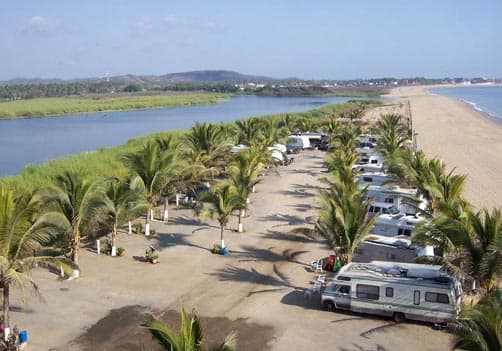
Above: Laguna del Tule RV park, Melaque
TCM: Let’s get right to the big question; is Mexico a war zone as we frequently are told by the media in the United States? Can you give us some first hand experience with this question?
Paul: Every time one talks about RVing in Mexico, this is the first matter that comes up. Anyone who tells you Mexico is hassle free or 100% safe are deluding themselves. However, the media in both the United States and Canada has blown the risks out of proportion.
Mexico is not a war zone, anymore than the United States was a war zone during prohibition, and there are many parallels to that period. There are areas of Mexico that are highly unsafe and should be avoided, such as Cuidad Juarez. Cuidad Juarez is, in fact, a war zone. Other trouble spots come and go. Right now, Acapulco and the Northeast state of Tamaulipas are possibly the areas to avoid. The astute traveler will keep updated on problem areas.
I believe the risks to RVers in Mexico are highly overestimated. A single incident in Mexico sends people running for the hills. A similar incident in the United States or Canada appears to get shrugged off. That is not to say one should not remain wary and alert. Your chance of being a victim of property crime is higher, simply due to the economic differences between Mexico, the United States, and Canada.
Mexico is also very different country in terms of language, culture, and laws, all of which are waiting to trip up the unwary. Most people are pleasantly surprised at just how generous and helpful the majority of Mexicans are towards RVers, especially when you do run into trouble. This year was my fourth season in Mexico, by the way. Now we have the usual question out of the way, let’s talk about logistics.
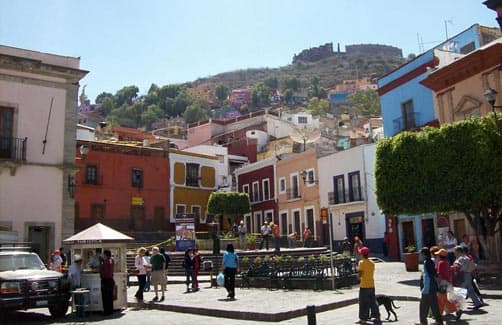
Above: Colonial city of Guanajuato, Mexico
TCM: Talk to us about the procedure for taking a truck camper into Mexico. Specifically, tell us about insurance, permits, vehicle registration, and anything else one needs to cross the Mexican border, and get back again. The back again part is particularly important.
Paul: Mexicans love paperwork. This means that you really have to have all your ducks in a row before crossing the border. You will need originals of all vehicle registrations. If your truck is leased, or is a company owned truck, you need notarized permission to take it into Mexico, even if you are the company owner.
Having a couple of copies of all your documentation is also advisable. I would also carry a copy of any original sales agreement. If you are from a State or Province that does not require truck camper registration, it is a good idea to carry the original sales agreement, although I have never been asked.
You should also have a copy of Mike and Terri Churches “Mexico Camping“ book. This is the bible and contains valuable information on individual crossing points. No Mexican RVer should be without a copy. I recall Truck Camper Magazine interviewed Mike and Terri a few months back. I frequently run into them, and their Adventurer truck camper in Mexico.
A vehicle permit is required unless you are traveling to Baja or remaining in northern Sonora State, known as the hassle free zone. Permits are issued by the Banjercito and usually you have to locate the offices which are often ten or twenty kilometers south of the border. You will be required to have vehicle registrations, a drivers license, and a credit card.
Unless you have obtained one beforehand, the first order of business is to locate the immigration desk and get your six month tourist card. As soon as you do this, look for the usual copy booth and make copies of it. They will ask when you move on to the Banjercito window to get your permit.
If there is no copy booth they will usual do the copy themselves. A vehicle permit will be issued for your truck and any other vehicles, like a tow car. This costs around $40 for six months. If you have a trailer, scooter, etc, they will generally add those to the same sticker. If your camper is licensed, you may be required to purchase another one for your camper, but that is unlikely. It is possible to get a ten year permit for the RV itself, but I advise against it. If you sell your RV and then try to re-enter with a new rig, you will have no end of hassles.
My advice is to copy all documents they issue you and, if possible, scan and email them to yourself. I also do this with all my vehicle registrations so I can access copies on the road in a worse case scenario. I now carry a small portable scanner and printer with me. Banjercito will also take note of your credit card number and, if you do not return with the vehicle, you will be charged duties. If you replace a windshield, make sure you salvage the piece with the permit affixed. Another reason I email a copy to myself, in case I am unconscious from an accident and unable to do that.
Upon leaving Mexico, you have to return the permit at the same Banjercito or a Banjercito at another crossing. They will remove the permit, scan it, and take a photo of your VIN tag. If you declared a trailer, scooter, or any other vehicle, make sure they are aware of them. They will issue a receipt. Do not throw it out. If you return the following year make sure you have it with you, just in case.
Your United States and Canadian insurance is not valid in Mexico. You can purchase Mexican insurance in most border towns on the United States side or online. You can expect to pay about $100 for every $10,000 of coverage. Make sure you have both collision and liability coverage. The insurance company should also provide you with a bilingual lawyer in case you do have an accident. Many policies will also allow you to have repairs done in the United States if the vehicle is drivable.
Unfortunately, if you do have an accident, your vehicle will be impounded until things are sorted out. If you injure someone, you may also find yourself in jail until things are sorted out. That is why the lawyer is so important and the very first thing you should do if you have an accident is call your insurance company. For that reason I recommend carrying a cell phone. I can discuss that further on in this interview.
Some reliable insurance companies are Don Smith, San Xavier, and Lewis & Lewis and Sanborns. A six month policy is recommended. You need to ensure it covers all areas you plan to travel. You should also check with your normal insurance company. Many will rebate you for the time spent in Mexico. For that reason keep lots of documentation. For example, keep copies of the vehicle permit, exit receipts, campground receipts, toll receipts, etc. You may find you end up breaking even.
TCM: RV caravans to Mexico are nothing new, but more and more folks may be interested in them as concerns about safety in Mexico are heightened. What can you tell us about caravans into Mexico?
Paul: A caravan is a good way to get an introduction to RVing in Mexico. Most caravans these days operate in Baja, although one or two are doing the mainland. If you speak French, there are several Quebec companies that travel into mainland Mexico. A new trend we are seeing is RV parks running caravans to their park for a small fee, provided you commit to a couple of months. La Penita, just north of Puerto Vallarta and Celestino Resort, just north of Mazatlan, are two that come to mind. See http://www.celestinocaravans.com and http://www.lapenitarvpark.com.
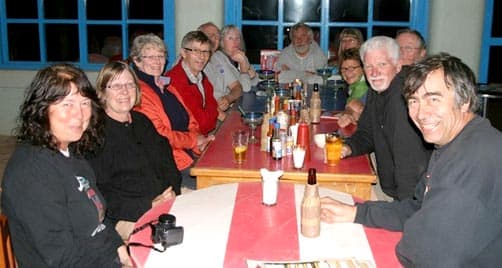
Above: Dinner at Huatabamapito with the travel buddies we found through www.mexicorvforums.com
TCM: If a Mexico newbie doesn’t sign up for a caravan, do you recommend crossing the border and traveling with a RV buddy? How would that work?
Paul: This trend appears to have taken off this last season. I did this myself for the first time, traveling with two other truck campers, a travel trailer, and a fifth wheel. We stuck together for a couple of weeks, especially for the first few hundred miles south of the border. We found the folks in one of the other truck campers particularly compatible and plan to travel together in future, possibly to South America. They live in the San Francisco Bay Area. Oddly enough, we first met them at the Host RV factory while on a NATCOA caravan in 2005.
Last year, I established a new web site, www.mexicorvforums.com to try and promote a “no-paranoia” information site for Mexican RVing. If you register on the forum there, you will find a calendar that you can enter your travel buddy request into. Others can then contact you via private mail. It worked well for many, last season, and, as it becomes better known, it should become a useful resource. I run that site on a non-profit basis as a means of helping the RV industry. Several Mexican businesses are advertising on it. I use the money to produce bumper stickers promoting RVing in Mexico. I will provide those for the cost of postage to anyone who would like a couple (see www.mexicorvforums.com/bumper.pdf). I apologize for the silhouette of the Class C on the stickers. If you would like one, you may contact me through that web site or [email protected].
TCM: Many readers would be concerned about navigating their way around Mexico. Can you successfully use a GPS in Mexico? Or are there better ways to navigate Mexico, like map books?
Paul: GPS maps for Mexico are not yet up to the standards of those for Canada and the United States. For this reason, I recommend finding a copy of Guia Roji, the definitive Mexican road map book. They can be found in large department stores in Mexico such as Mega or Walmart. You can also order them on line, but the site is only in Spanish; http://www.guiaroji.com.mx.
For GPS maps, I used to recommend BICI maps for either the Garmin or Magellan, but things have recently changed. Garmin now includes Mexico with its North American updates. I did a recent side-by-side comparison and they proved to be currently superior to BICI. BICI does, however, show contours. Garmin uses Navteq as their supplier.
Tom Tom uses Tele Atlas which also provides Mexico maps. I have no idea how good those are. A GPS is useful if you don’t completely rely upon it. If you have the Church’s book, they provide co-ordinates for over 400 Mexican RV parks and entering those into a GPS can help you locate them. Microsoft Streets and Trips also has very detailed Mexican maps. The big problem is Mexico’s love of one way streets. No GPS so far appears to be able to deal with those, nor do they tell you if a road is passable for an RV. Low trees, narrow streets, and archways are a big hazard in many Mexican towns.
I have an overview map on my web site showing the general location of RV parks and cross referencing with the Churches book. Some new ones since the book was printed also show on there along with their co-ordinates. Mike and Terri also regularly post updates on their site, www.rollinghomes.com.
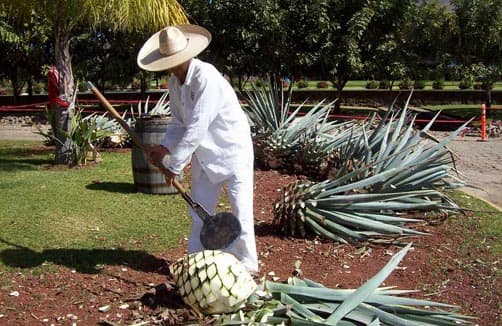
Above: An “El Jimador” removing the husk of the Agave root ball
TCM: There has been much debate on the use of toll roads in Mexico. Please give us some insights into the use of toll roads and whether or not you recommend them.
Paul: Certainly for the newbie, one should use toll roads whenever possible. A camper on a single rear wheel truck will pay the same rate as a car. It gets more expensive every time you add an axle and a dual rear wheel truck is considered an extra axle.
The free roads, however, can be false economy. They are often windy, hilly, slow, and you may find you burn enough extra fuel to cover what would have been the toll. Most toll roads are up to United States interstate standards. They are faster and safer and they provide you with free towing and will even cover the cost of some repairs if you breakdown, or your vehicle is damaged. They are also free of the ubiquitous “Tope”, or speed bump, which are found all over Mexico.
TCM: The police in Mexico are notorious for shakedowns and asking for bribes, aka Mordida. Is that a real concern and how should a RVer handle that potential experience?
Paul: Unfortunately this is still widespread and any RV’er will likely encounter it at least once on their trip. It is also illegal to pay a bribe. You seldom see this with Federales anymore, a recent purge of dishonest cops and better pay has all but eliminated it.
It is another story with municipal and transit police. The first piece of advice is to smile, even shake their hand, and do not appear irritated. I have found the best initial strategy is to pretend you speak no Spanish. They will sometimes give up in frustration. If you obviously did nothing wrong, tell them you will follow them to the station and pay the fine. This will often result in a warning. If they speak English, another tactic that worked this year for me, was to tell them how much I loved their country and how I tell all my friends to RV here, and so on, heaping copious praise on Mexico. In that particular instance, I was actually in the wrong. He let me off, I gave him my card, and told him if he ever makes it to Vancouver I will show him around (I will).
Mexicans are very proud of Mexico and this strategy will often make them feel guilty about shaking you down. If all else fails, ask the officer for his identification and write down his information. If the ticket is bogus, he will likely back off.
You should make every effort not to hand over any cash unless he provides you with a receipt containing his name and badge number. Some people say take his photo. I would really not advise doing that. If you are in the wrong, pay the fine and get a receipt. Don’t try to buy them off for a lesser amount, it only encourages the practice.
I have not always followed my own advice in the past. On one occasion, when I had serious doubts I could maneuver my rig into the narrow, tight streets of the town, I asked the officer to pay the fine for me. Obviously it went into his pocket.
TCM: Any diesel truck bought in the United States on or after 2006 uses Ultra-Low Sulfer Diesel (USLD) and is not compatible with non-USLD diesel. The issue is that you supposedly can’t get USLD in Mexico. What’s the story there?
Paul: This subject is almost as controversial as the safety issue. Mexican diesel is supposedly 30 ppm sulphur and USLD is 15 ppm. Somebody on a forum claimed they took a sample to an environment lab and it tested at 16 ppm. Next year I am going to take sample myself, since my wife was an environmental chemist and still has access to getting it tested. This should hopefully settle the issue.
I wish I had thought of it this year. I feel Mexico is at least two years away from officially having USLD. It is available close to the border where fuel is imported from the United States. I have seen plenty of people taking later model trucks down. I don’t think four or five tanks will hurt and that will get you from Nogales to Mazatlan and back.
A number of people have attached extra tanks and are running 50/50 United States and Mexican diesel. This is doable with a fifth wheel or travel trailer, but not with a truck camper. I know one person who has taken his post-2006 diesel truck to Manzanillo and back for the last three years with no issues. I certainly would not mention to your dealer that you have taken it into Mexico.
Fuel prices in Mexico are considerably cheaper. As of the writing of this article in May of 2011, diesel works out to $3.10 per United States gallon or 80 cents per Canadian liter. I have written a handy little fuel price conversion utility in Microsoft Excel that you can download at http://www.natcoa.net/convertor.xls. All fuel in Mexico is sold by Pemex and price is consistent across the country. Diesel pumps are black, not green.
Rip offs at Mexico gas stations are less common these days. Regardless, get a locking cap and ensure the pump is zeroed. I always tip attendants 20 or 30 pesos. They appreciate it and are probably less likely to try to rip off the next gringo.
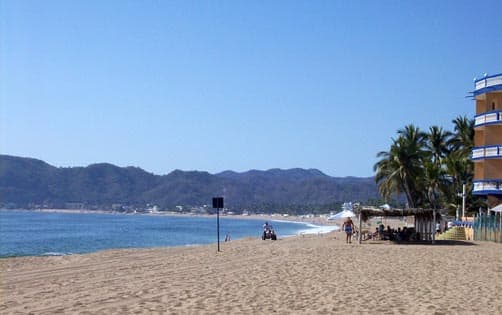
Above: Beach in front of Laguna del Tule RV park, Melaque
TCM: Are there any special precautions one should follow concerning possible RV repairs and RV part availability? Should we bring spares for anything?
Paul: RV parts are pretty well unknown. With a truck camper, space is limited, but I would carry a spare sewer hose and fittings, a spare water pump, a spare oil filter, and a spare fuel filter. Also a roll of Eternabond tape in case you damage your roof. I learned about the sewer hose the hard way.
One option if you find yourself in trouble is to place a post on RV.net and mexicorvforums.com and see if you can match up with someone still in the US coming your way. It worked for me.
You will need to buy a large water jug for drinking water. You can find screw top water jugs in Mexico. Refilling them is very easy and cheap almost anywhere. I would advise against carrying it in your shower stall as I know one person who cracked theirs when they hit a tope at high speed. If this is your only storage option, put some foam rubber under the jug.
One expensive item everyone should have is a power surge protector. These come in built in and portable versions and can be obtained at Camping World for about $275. Voltages in Mexico can range from 85V to 150V. If you do not have one, make sure you at least run your fridge on propane.
I know in Melaque, there is a United States trained RV technician who can repair many things. People at Laguna del Tule RV park know who he is.
The good news is that vehicle dealers in Mexico are cheap and you can find Ford, Chevy, and Dodge dealerships. Any work they do is covered under warranty back home. Unfortunately, since they do not sell diesel pickups in Mexico, you may find yourself waiting for parts to be shipped in from the United States. I only paid $40 labour a few years ago at a dealer to have my water pump replaced.
TCM: While many truck campers shy away from the use of RV parks and campgrounds in the United States and Mexico, they seem like a good idea in Mexico. That said, there have been some warnings from the government about violence and the current state of Mexican RV parks. Tell us about that.
Paul: Attendance at RV parks was definitely down this year. If it continues, many parks may close. This is likely a direct result of a Canadian government warning about driving in Mexico as Canadians make up the largest number of RVers in Mexico, by far.
However, after a chilly winter in Arizona, many Snowbirds that are Mexican regulars have told me they will be back next year. Trading an Oceanside resort in Mexico for a piece of chilly desert is not appealing to many.
Mexican campgrounds range from $10 to $25 a night. An oceanfront site with full hook-ups and pool on the west coast near Mazatlan, Puerto Vallarta or Manzanillo, will run $500 to $600 a month. Boondocking is not a good idea unless you are a large group. Despite that, George and his Class C, “Ms. Tioga”, spend many months a year boondocking in Mexico. See http://blog.vagabonders-supreme.net.
Many RVers head to one favorite location and spend months, usually on the coast. This is a bit of a mistake as there are some wonderful inland areas and colonial cities to visit. San Miguel Allende, Guanajuato, and Patzcuaro, just to name a few. When the weather gets hot in late March, inland can provide welcome relief.
Within a couple hours drive of Guadalajara, for example, are several wonderful RV Parks. To the west, near Tepic, is Lago Santa Maria del Oro, a wonderful fresh water lake in a volcanic crater. To the east is Chimulco RV Park at Villa Corona, with its hot spring pools. On the Western shore of Lake Chapala is Roca Azul, also with hot springs. To the south, near Mazamitla, is one of my favorite RV parks, Hacienda Contreras. A park made extraordinary by its owners, American ex-pat Barb Contreras and her Mexican–American husband, Sal. They regularly take their guests to the many attractions in the area, such as hot springs, zip lining, and horseback riding. Also near Guadalajara is the town of Tequila. A tour of the historic Herradero distillery on the east side of the town of Amatitan, is highly recommended. This is the destination of the famous Tequila train that runs daily from Guadalajara.
For those in the east, VillasTepetapan in Catemaco, Veracruz is a perennial favorite. It is also American run. I am aware of about 490 suitable camping sites in Mexico at present, ranging from beach palapas to United States style RV resorts.
TCM: Staying in touch with what’s going on in the world is important to most of us these days. Do satellite radio and television work in Mexico?
Paul: Satellite radio works well. The best option is Sirius, rather than XM. Sirius has their satellites in a higher orbit and it makes a difference in Mexico. United States satellite television service providers Dish and Direct work a few hundred miles south of the United States border, but require a large dish much further south than Mazatlan.
Oddly enough, the Canadian Shaw Satellite (formerly StarChoice) works all over Mexico. I have seen a few Americans getting Shaw Satellite via the grey market. It carries most United States channels as well as Canadian. The Canadian Bell ExpressVu service is in the same boat as Dish and Direct with regard to coverage, not very good.
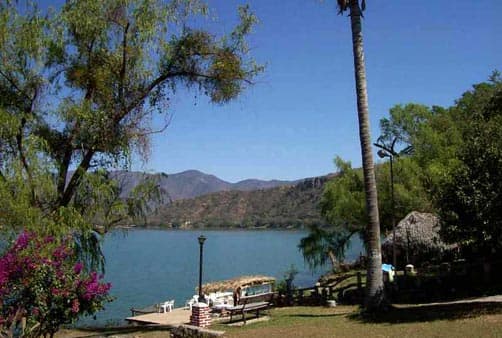
Above: Koala RV Park, Santa Maria del Oro
TCM: Most of us want or need to stay in touch with friends and family back home. A few of us even need to run our business while we travel. Tell us about cell phone options. And how about cellular internet?
Paul: Cell phones are cheap in Mexico. You can get a Telcel internet stick for your laptop for a very reasonable $40 a month. I actually recommend people bring an AT&T GoPhone from the United States. These cost about $15 at Walmart and you can purchase a $50 card for six months or $100 for a year. They roam on the Telcel network which has extensive coverage all over Mexico, including along highways. The rate is 25 cents a minute for all calls including those to and from the United States and Canada. (10 cents when in the United States). While the rates are higher than a Mexican cell, the big advantage is it has a United States number. You can simply call forward your home phone to it. Since call display (caller ID) works almost everywhere, you can either answer or let the call go to voicemail. Local calls are made in the same way as a Mexican cell. To call Canada or the United States, simply put +1 in front. I have also had good results with MagicJack, even over Wi-Fi. Skype is always an option as well.
TCM: Can you find reliable and fast WIFI in RV parks and other locations?
Paul: Wi-Fi is more prevalent in Mexican RV parks than United States campgrounds. In many cases, the RV park even has repeaters for full coverage. I actually installed an outside WI-FI antenna this year with excellent results. At many parks I was able to use my computer inside my camper, whereas last year I had to go near the office. I use an antenna made by innovative devices (www.innovativedevice.com). It costs about $100. I rigged it up to my TV antenna so I could rotate it from inside the camper. It hooks into a USB port on your computer. I ran the cable down the fridge vent.
You should check with the park before using Skype or MagicJack, some are using satellite internet and do not appreciate you running up their bandwidth allowance. Most are on TelMex DSL, however.
TCM: Is there anything else you would recommend to someone who’s interested in traveling in Mexico with a truck camper?
Paul: I would like to return to the safety issue. It is good to be aware and alert to potential trouble, but I am sure that once you have experienced a season in Mexico you will feel much more confident the next time around.
Mexico is a fascinating country and you will experience RVing in a whole new way, hopefully a positive one. As I often tell people, I did not work thirty years to sit at home and get my travel thrills watching the National Geographic Channel. Get out there and enjoy. There is an RV world beyond the United States and Canada.
Five Mexico travel websites well worth checking out:
www.mexicomike.com – “Mexico Mike” Nelson is probably one of the most knowledgeable individuals when it comes to traveling in Mexico. While his site is not RV oriented, he has driven many 1,000’s of miles there and has unique insights.
forums.bajanomad.com – An extremely active forum on Baja, Mexico. A great source of information, if Baja, Mexico is your destination.
www.expatforum.com/expats/mexico-expat-forum-expats-living-mexico – A forum for gringos living in Mexico. Often has good information on immigration procedures.
www.rversonline.org/RV4Mex.html – Dave Eidel has RV’ed extensively in Mexico.
www.ontheroadin.com – This site contains interactive maps of Mexican RV parks.
RV parks mentioned in the article, that are not already linked:
Hotel Mirador, Huatabampito – http://www.elmiradorrvpark.com/index_english.html
Laguna del Tule – http://www.lagunadeltulebungalows.com/eng
Hacienda Contreras – www.haciendacontreras.com
Roca Azul – www.roca-azul.com
Chimulco RV park – chimulcotrailerpark.com
Villas Tepetepan – www.gaudis.com
